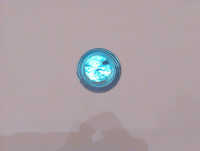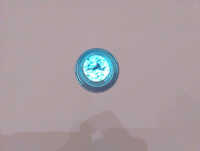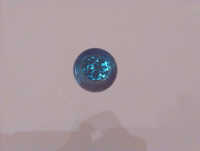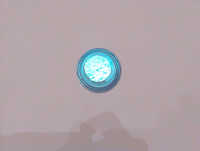
chance is an event without cause
ghostradio ghostradio is a fieldtest by pamela neuwirth, franz xaver and markus decker. ghostradio is a second order cybernetic mechanism that generates random numbers by chance. this unit works on the boundaries of the causal world and beyond. we are publishing this random numbers datastream for cryptographic key generation. this will release the public from the current state of surveillance. when descartes described his foundation of the enlightenment in the sentence, - i think, therefore i am - he accidentally created the new metaphor for the machine age, in the aftermath of the industrial revolution and pure reason. centuries later the macy conferences introduced the concept of cybernetics to the field of science, and the principle of thought was described by computing, command control circuits and data processing as man-machine. rationality and objectification was the ideal of this culture. however, this culture is problematic for our societies, as the panopticon of the supercomputer seems to be supernatural. instead of using these technologies as examples for social development, man-machine finds it rather important to fetch all relevant communication data and copy the whole internet for content analysis to create a shift from free communication to a cage of surveillance. at the moment, all those connections and information exchanges made in the internet, are more or less plaintext information, like as we would type on the old telex machines. for some of this exchange mechanisms we use a "secure" transmission, for instance, in online banking, shopping, video and telephone transmissions. they are considered as "safe", although they are not, even though the information is encrypted. to be able to use encryption with a known cryptographic method it is essential to create a good random key. because the cryptographic method is known, all the security of the transmission relies on the key. usually these keys, a stream of numbers, are made by pseudo random generators, which calculate their randomness using mathematics. this is a good way, but it is not random. beside the fact that all the available software for security measures is hacked via backdoors, or that the pseudo random generators use weak mathematics, the main idea, of calculating chance, is simply wrong. it will work to some extent, but all these errors make your communications and private sphere weak and accessible to others. thus, to avoid such weak cryptographic keys we create a random ghostradio source online, and from which we will publish a datastreamfile of the ghostradio numbers for public use. in watching the movie, "the net" by lutz dammbeck, we see where von foerster fabulates about academic research in contrast to the arts as a feedback system: they do research, we do search. he denies the existence of the term reality completely, and this is the connection between the search for chance and art. in art history so-called chance plays a prominent role. examples of chance in the art praxis include a work by christian marclay, his lp without a cover, where the usage of the vinyl disk will ultimately result in unintended additions to the sound stored on it, and in the composition 0"00' by john cage, which has no instructions for the orchestra. snapshot photography and abstract painting round out such a method, along with the ubiquitous tool for music and image in electronic media, the pseudo random generator as noise. john cage made a nice statement about the complexity of chance: "by using chance operations (mathematic or a dice) the basic elements of this domain are more or less well known. whereby using the methods of uncertainty, I have the feeling of being outside the known universe, and dealing with things, I don't know about." the so-called chance on the other hand, is our daily companion. you meet you friend accidentally on the street, you make random decisions, the lottery selects the numbers by chance, and so on. but all these contingencies are just interconnected parallel activities. for instance, each individual has his daily routine and the other individuals their daily routines which coincidentally overlap each other. the lottery ball still obeys physical principles, and the number is drawn on a certain place at a definite time. these random events are everything else except just not random. chance is defined as a event without a cause. where in the causal world could chance exist? we believe chance could also occur in the anomalies of nature, in our dreams, by taking drugs, or in art. chance exists within the background noise from outer space as macro-universe, and in the events of radioactive decay as micro-universe. these are the most prominent examples of chance in quantum mechanics. in both we are able to detect random events. 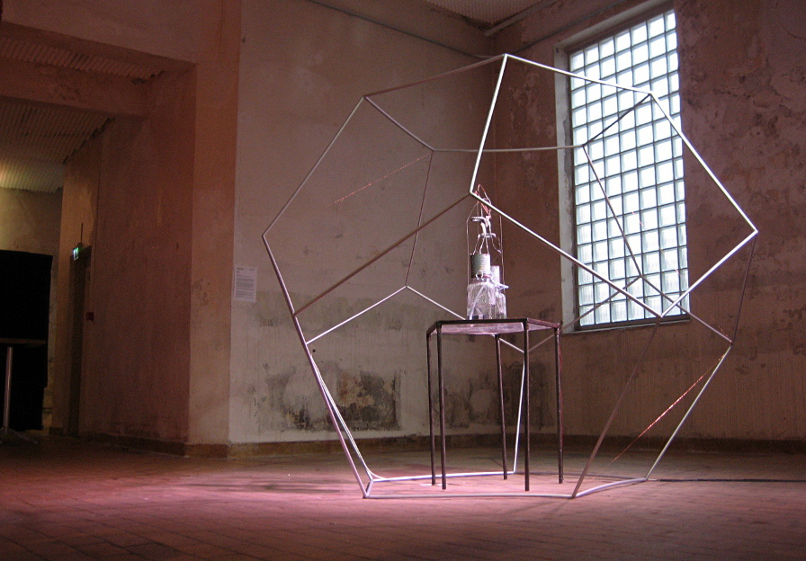
ghostradio 2014 with the ghostradio project, we are working on the subject of chance. we won't use any of the anomalies or the boundaries of the causal world as described above, instead of we are taking the far broader approach to the possibilities arising in definitions of string theory and the existence of the multiverse. the ghostradio method functions with feedback and quantum-effects, losing time and space relevance through the creation of transformation entropy with a shift to the boundaries of the parallel world within the same plot but with a different story, that of our doppelganger. the ghost.
the name ghostradio originates from the ghost-hunters. they try using technical equipment to receive voices and images from beyond the grave. exhibiton and signal-search-territories for the exhibtion we build a mechanism based on the principles of the lord kelvin thunderstorm generator and an em-data transmitter in a dodecahedron dome. the thunderstorm generator is a physical structure which creates a electro static field with natural elements, the force of gravity and water. in a symmetric arrangement water drops fall through metal rings, each with a crossover connection to one another. this potential energy generates a electrostatic field which is strong enough to create electrical power and then able to deflect the water and move the spray against gravity. within this field we are broadcasting a electro magnetic feedback loop over pentagram antennas to interfere with the thunderstorm generator. out of this feedback loop we extract a random signal as a source of chance. materials: lord kelvin thunderstormgenerator, tv broadcast unit, dodecahedron dome, pentagram antennas, computer. techrider: minimum space requirement 30 square meter, ethernet, 6 powerplugs 230v, storage space, adequate lighting.
pamela neuwirth *1976 lives in linz and works as author, free journalist and radio editor. at the moment she also works as an undertaker (mortician). during several working-collaborations with artists and writers she currently investigates fascism and architecture (Demant revisited), art-brut and psychiatry (irren-Offensive), and the field of chance and cryptography (ghostradio Project). markus decker is an artist and cultural worker based in the city of linz. in his working situations he is interested in interdisciplinary collaborative experience and in the praxis of the open knowledge and open technology circles. in recent years he is focusing the search for information processes and information theories about the entropy in feedback systems and natural phenomenons. he produced sound installations, sound improvisation and noise performances and created spatial experimental situations, which have been shown internationally since the late 90ties. some of his frequent collaborators are dietmar offenhuber, ushi reiter and servus.at, laura beloff, dilemma and interstellar records and richard herbst, erich berger among others. http://www.firstfloor.org/ae franz xaver (1956) has studied at the academy of applied art, department of ”visual communication” founded by peter weibel. subsequently he was teaching computer languages, audio-visual productions, electronics and electrical technics at the same academy until 1992. at the technical university of graz he was lecturing at the departure ”institut fuer baukunst” - ”communication theory”. he was participating in numerous exhibitions in austria and abroad, including ars electronica, aperto biennale di venezia, triennale milano, bonn kunst und ausstellungshalle from germany. since 1995 he has been working regularly with the art-label KUNSTLABOR and FUNKFEUER with the first wireless internet service provider ”silverserver”. from 2003 to 2007 he has been running the medienkunstlabor in the kunsthaus graz. Since 2008 he is a worker in the team of the stadtwerkstatt linz. http://xav.net/ contact: ghostradio ..at// firstfloor.org credits: michael fuereder, franz koppelstaetter, rixc, debian, jonathan kemp, armin medosch, art university linz, stwst, servus.at the work ist licensed under copyleft http://artlibre.org/licence/lal/en free art license |
